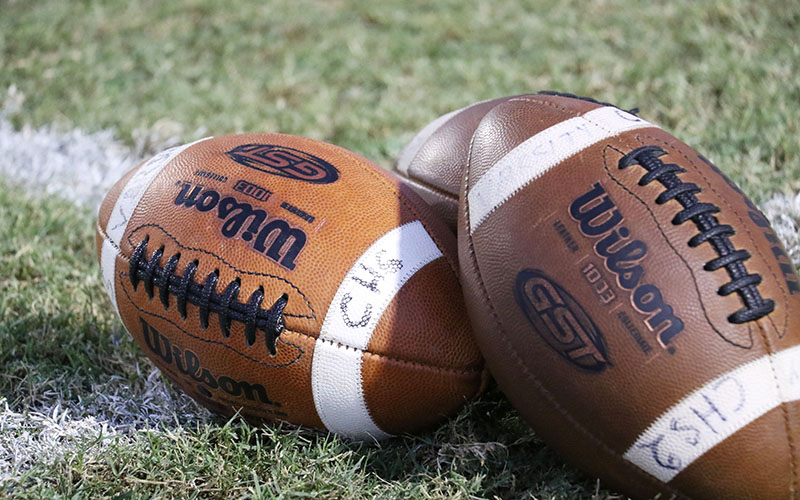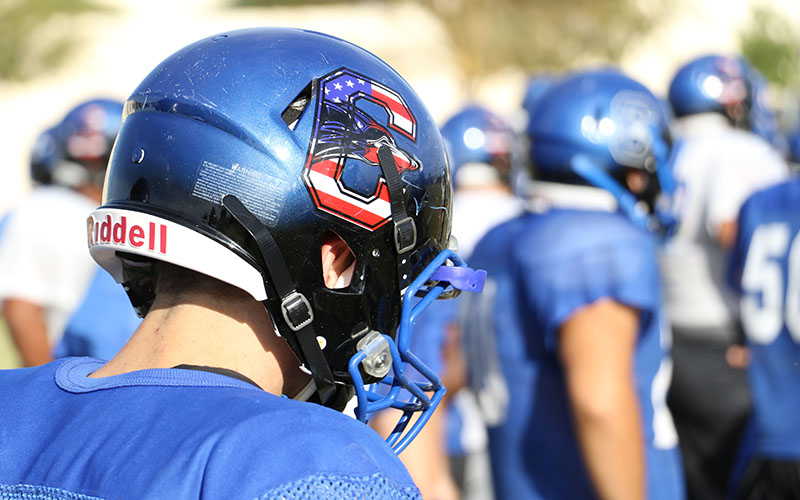PHOENIX – It’s one of the most important decisions parents have to make: Where will their child go to school? The open-enrollment policy in Arizona high schools can make the decision even more complicated, especially for athletically talented students.
According to the Education Commission for the States, every state (and the District of Columbia and Puerto Rico) other than Alabama or North Carolina has some sort of open-enrollment policy. Arizona and 36 other states or territories have open-enrollment policies that make it easy for parents to send their children to any high school of their choosing.
However, the open-enrollment policies apply to academics, not athletics. While athletes in Arizona are able to initially enroll at any school without penalty, the Arizona Interscholastic Association implemented a new policy in 2016-17 that requires athletes to sit out at least half a season if they transfer to a new school, regardless if the student-athlete’s residence has changed.
“Our philosophy has been that education is your right, and athletics is a privilege,” said David Hines, who takes over as executive director of the AIA in June. “We follow state law when it comes to their first enrollment in Arizona and their eligibility. Once they transfer, it becomes the part that’s tough to manage.”
The open-enrollment policies encourage students to be able to choose where they go to school. This does not mean, however, that high school coaches are allowed to actively recruit incoming high schoolers or potential transfers to come to their school.
Once a student-athlete transfers to a new school, he or she is required to sit out of at least 50 percent of an athletic season, according to the new policy. If the student transfers a second time, he or she must sit out an entire year.
And if an athlete transfers in season, he or she must sit out an entire year.
Transfers, Hines said, have become an issue not just for the AIA but also for several state athletics boards in recent years.
“It is a national issue,” Hines said. “Across the nation, this is one of the top priorities, eligibility and transfers. I think it’s the perception that there’s always something better at another school. Either college coaches will see you at a big school, you’ll be noticed, (and) have a better shot for a scholarship.
“We think that, for college coaches, their job is to find talent. And no matter where you go to school, if you have what they are looking for, they’ll find you. That has been proven over time.”

Footballs rest on the ground before Chandler High School’s football game against Basha High on Friday, Sept. 30, 2016 at Austin Field in Chandler, Ariz. (Photo by Fabian Ardaya/Cronkite News)
Former Chandler High School wide receiver and current Oregon State signee Dionte Sykes said his transfer from Basha High School was recruiting-based. Sykes, who was eligible to play right away under the old policy because he moved homes, said his transfer paid off instantly: He saw one college recruiter during spring football in his time at Basha, he said, while spring practices at Chandler drew coaches ranging from junior college programs to Division I.
“Chandler was where I needed to be the whole time,” Sykes said. “The exposure that you get, it changes instantly once you step foot on campus and once you become part of the team.”
Chandler High, with an International Baccalaureate program to boast of academically, the Chandler Center for the Arts on campus for extracurricular programs and a nationally ranked football program, has become one of the biggest landing spots for high schoolers with Division I aspirations.
Each of the school’s last four quarterbacks have gone on to earn scholarships from Pac-12 schools. None of the four, plus current starter and rising junior Jacob Conover, lived or live within the school’s boundaries.
“I enjoy open enrollment,” Chandler football coach Shaun Aguano said. “The reason why I like open enrollment is because my kids are on open enrollment, too; and I’m going to look for the best place that fits for my kids as well from a culture standpoint, from an academic standpoint and an athletic standpoint. I think that Chandler High fits all of those molds.”
Sykes said his visit to Chandler’s campus was eye-opening, and not because of what he wanted to accomplish in terms of landing a scholarship or being successful on the football field.
“They don’t talk about football,” Sykes said. “Not one bit. They are worried about you coming in and working hard not in the weight room or not even on the football field, but in the classroom. That’s a big part of why Chandler is so successful, I think.”
Hines said the AIA is watchful for recruiting and tampering in transfer cases, but said most of the problem doesn’t come from coaches — it’s from parents. Hines said playing club sports before high school builds relationships between kids and between parents, leading them to all want to attend the same school when it comes to picking a high school.
“Sometimes, they’ll say, ‘Hey, if we all go to the same school, then we’ll be better,'” Hines said. “I think there’s more of that going on than coaches outright recruiting.”
If a student-athlete like Sykes were to transfer schools now, he would have to fill out an AIA Form 250, which must be signed by both athletic directors and certifies that the transfer didn’t involve any impropriety. The form asks about the student’s living situation, reasons for the move, the motive behind the transfer. And it seeks to weed out recruiting by coaches or members of the programs.
The rule allows student-athletes to have their cases heard in the form of an appeal, meaning they will have to show some form of hardship in order to avoid sitting out. Hines said a hardship must be something “unforeseen, unavoidable and uncorrectable,” such as a parent no longer being able to afford tuition at a private school or a job transfer that uproots a family across the state.
Hines said the biggest loss from having an open-enrollment policy is the loss of community in high schools. While schools in areas with strictly enforced closed boundary areas can have a reasonable expectation of knowing what their class size will look like and which kids they can expect to have in the school, open enrollment creates variances. It also means the school’s athletic accomplishments may not be attributable to the community.
For example, Chandler High School has won two big-school state championships in the time since Sykes transferred to the program. Hines argues it is difficult for parents to root for a team that won two titles with players who are not from that area.
“We are losing some of our community schools, where you grew up in an area and the whole community could get behind kids when they compete,” Hines said. “Now, you have some schools where some of their best kids aren’t from that area and so they don’t have quite as much community support.”
Chandler High School Principal Larry Rother said he understands the concern for losing the community aspect of high school athletics. However, he said his goal is to provide a school that helps as many students as possible. Rother estimates that about three in every 10 Chandler High School students come from outside of the school’s boundaries.
“I like when communities support their schools, but I also believe that students have to make a choice on where they go to school based on what’s best for them,” Rother said. “I take pride in the fact that three out of every 10 of our kids choose Chandler High School.
“If a student demonstrates that they want to work hard and they want to follow the rules and they want to take a great education opportunity that we offer here in Chandler, I want them to come here.”
For as much as parents want their kids to go to the best schools possible, administrators and coaches say they have put just as much emphasis on making sure their school or program is the most attractive possible for people to want to go there. Former Hamilton High School football coach Steve Belles said his goal when he was coaching was to make his school a “destination place” not just for athletes, but for students.
The goal, Hines said, is understandable. Coaches want the best players possible, regardless of where they come from, and making their schools attractive is one way of doing so without flat-out recruiting.
“I think, obviously, coaches would like to have the best talent possible,” Hines said. “If schools or programs have been successful, they tend to have coaches that have been there quite a while and sometimes that’s a factor in where people choose to go to school. I think that’s probably the No. 1 factor.”
